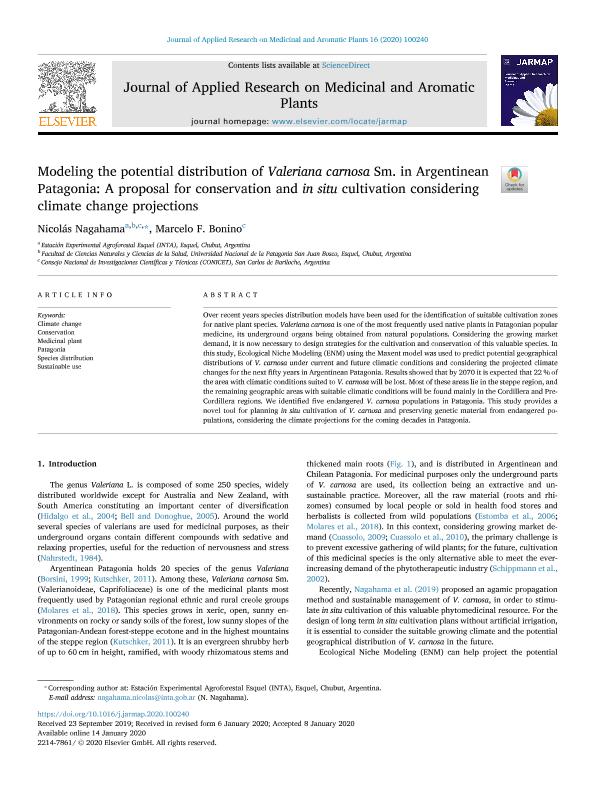Mostrar el registro sencillo del ítem
dc.contributor.author
Nagahama, Nicolas

dc.contributor.author
Bonino, Marcelo Fabián

dc.date.available
2020-07-03T17:46:52Z
dc.date.issued
2020-03
dc.identifier.citation
Nagahama, Nicolas; Bonino, Marcelo Fabián; Modeling the potential distribution of Valeriana carnosa Sm. in Argentinean Patagonia: A proposal for conservation and in situ cultivation considering climate change projections; Elsevier Gmbh; Journal of Applied Research on Medicinal and Aromatic Plants; 16; 3-2020; 1-8
dc.identifier.issn
2214-7861
dc.identifier.uri
http://hdl.handle.net/11336/108769
dc.description.abstract
Over recent years species distribution models have been used for the identification of suitable cultivation zones for native plant species. Valeriana carnosa is one of the most frequently used native plants in Patagonian popular medicine, its underground organs being obtained from natural populations. Considering the growing market demand, it is now necessary to design strategies for the cultivation and conservation of this valuable species. In this study, Ecological Niche Modeling (ENM) using the Maxent model was used to predict potential geographical distributions of V. carnosa under current and future climatic conditions and considering the projected climate changes for the next fifty years in Argentinean Patagonia. Results showed that by 2070 it is expected that 22 % of the area with climatic conditions suited to V. carnosa will be lost. Most of these areas lie in the steppe region, and the remaining geographic areas with suitable climatic conditions will be found mainly in the Cordillera and Pre-Cordillera regions. We identified five endangered V. carnosa populations in Patagonia. This study provides a novel tool for planning in situ cultivation of V. carnosa and preserving genetic material from endangered populations, considering the climate projections for the coming decades in Patagonia.
dc.format
application/pdf
dc.language.iso
eng
dc.publisher
Elsevier Gmbh

dc.rights
info:eu-repo/semantics/openAccess
dc.rights.uri
https://creativecommons.org/licenses/by-nc-nd/2.5/ar/
dc.subject
CLIMATE CHANGE
dc.subject
CONSERVATION
dc.subject
MEDICINAL PLANT
dc.subject
PATAGONIA
dc.subject
SPECIES DISTRIBUTION
dc.subject
SUSTAINABLE USE
dc.subject.classification
Conservación de la Biodiversidad

dc.subject.classification
Ciencias Biológicas

dc.subject.classification
CIENCIAS NATURALES Y EXACTAS

dc.title
Modeling the potential distribution of Valeriana carnosa Sm. in Argentinean Patagonia: A proposal for conservation and in situ cultivation considering climate change projections
dc.type
info:eu-repo/semantics/article
dc.type
info:ar-repo/semantics/artículo
dc.type
info:eu-repo/semantics/publishedVersion
dc.date.updated
2020-06-08T15:12:13Z
dc.journal.volume
16
dc.journal.pagination
1-8
dc.journal.pais
Alemania

dc.journal.ciudad
Munich
dc.description.fil
Fil: Nagahama, Nicolas. Instituto Nacional de Tecnología Agropecuaria. Centro Regional Patagonia Sur. Estación Experimental Agropecuaria Esquel; Argentina. Consejo Nacional de Investigaciones Científicas y Técnicas; Argentina
dc.description.fil
Fil: Bonino, Marcelo Fabián. Consejo Nacional de Investigaciones Científicas y Técnicas. Centro Científico Tecnológico Conicet - Patagonia Norte. Instituto de Investigaciones en Biodiversidad y Medioambiente. Universidad Nacional del Comahue. Centro Regional Universidad Bariloche. Instituto de Investigaciones en Biodiversidad y Medioambiente; Argentina
dc.journal.title
Journal of Applied Research on Medicinal and Aromatic Plants
dc.relation.alternativeid
info:eu-repo/semantics/altIdentifier/url/https://www.sciencedirect.com/science/article/pii/S2214786120300012
dc.relation.alternativeid
info:eu-repo/semantics/altIdentifier/doi/https://doi.org/10.1016/j.jarmap.2020.100240
Archivos asociados
